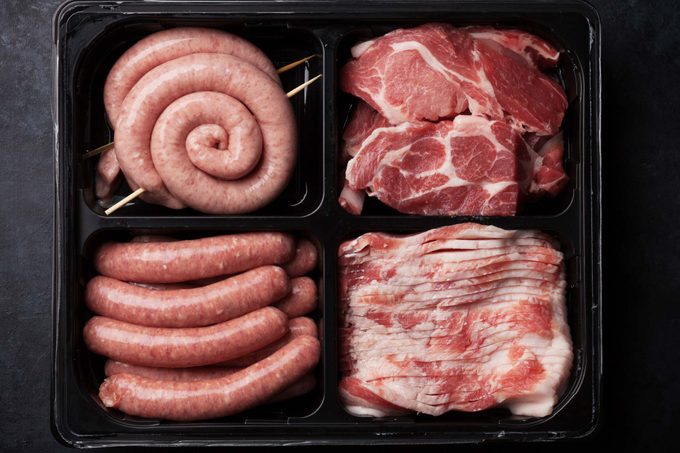Meat glue is common in many processed foods. But how safe is it?

The Gross Meat Ingredient You’re Probably Eating

Fresh meat is always the best choice in the meat department. However, it isn’t always an option. The phrase “meat glue,” used in many processed foods today, is likely to elicit a few scrunched noses or raised eyebrows, and the image of “gluing meat” together seems entirely unappealing.
Transglutaminase (TG)—or meat glue, as it’s commonly called—is a widely used ingredient. However, it’s a controversial food additive. Indeed, in 2010, the European Union banned its use. But the United States Department of Agriculture (USDA) still allows it, and the Food & Drug Administration (FDA) classifies meat glue as “generally recognized as safe.”
But what is meat glue, how is it used and is it safe for you to consume? Read on for everything you need to know about transglutaminase.
Get Reader’s Digest’s Read Up newsletter for more humor, cleaning, travel, tech and fun facts all week long.
What is meat glue?
Meat glue, or transglutaminase, is an enzyme that is found naturally in humans, animals and plants. It can form bonds between different types of proteins or different pieces of protein, which is why it’s been given the nickname “nature’s biological glue.”
These enzymes serve several purposes, and not all of them involve meat products. Indeed, TG can be used in baked goods and dairy.

“Meat glue is made from cultivated bacteria from blood plasma from pigs and cows,” says Rebecca Park, RN. “Other meat glues are made from cultivated bacteria from vegetables and plant extracts. Most meat glues are mixed with other ingredients, such as gelatin and caseinate.”
Why is transglutaminase used?
“With the help of transglutaminase, small pieces of meat can be bound together to create larger, more uniform pieces,” says Ysabel Montemayor, RD. “It has been used to develop or improve the texture of a variety of products such as sausages, chicken nuggets, imitation crab, bread and cheese. ”
Pork tenderloin is a good example of how TG can be used. This cut of meat is naturally cone-shaped, with a broader, thick end that tapers to a smaller, narrower one. With TG, meat producers can “glue” multiple pork tenderloins together to create a tenderloin that has a uniform shape and size. This might be ideal in restaurants or catering companies where having even, equal sizes is preferred.
How much of our meat has it?
The American Meat Institute says about 8 million pounds of meat per year in the United States contain TG. In the U.S. every year, more than 49 billion pounds of meat are consumed. That means about 0.016% of all the meat in Americans’ diet has the enzyme. Other types of preservatives and food additives may be more common.
If you eat processed foods, such as sausage, hot dogs and chicken nuggets, your diet likely has a larger amount of that small percentage than the diet of someone who avoids the “glued” foods.
How can you tell if a food has meat glue?
The USDA requires meat, egg and poultry producers to list transglutaminase on ingredient labels, but they don’t have to write the word out in such clear terms. You may see “TG enzyme,” “enzyme” or “TGP enzyme” used. If the food you’re holding has used the enzyme at any point in the manufacturing process, it should also be labeled as “formed” or “reformed” meat.
For other products, including breads and dairy, the label may be less clear. If you’re unsure about the food you’re buying, contact the manufacturer.
Is transglutaminase safe?
The USDA and FDA both agree that meat glue is safe. However, some researchers and food experts have raised concerns.
The biggest concern—and ultimately the reason the EU banned the enzyme—is bacterial contamination. Each time proteins are “glued” together, the risk for introducing more bacteria, such as E. coli, goes up.
“The risk of food poisoning in food that is glued together is extremely high,” Park says. “This is because the smaller pieces of meats used have had a chance to grow bacteria before they are glued together.”
The glued meat may also be harder to cook, which increases the risk of foodborne illness. If heating can’t kill the potentially harmful bacteria, you could become sick more easily.
Are there any side effects or concerns?
According to a 2016 study in Autoimmunity Reviews, individuals with a gluten sensitivity or celiac disease may need to avoid foods made with TG. That’s because the enzyme may increase the allergic load in the body, potentially leading to serious reactions.
Individuals with weakened immune systems, digestive diseases, food allergies or sensitivities may be advised to avoid all foods containing trans fats (TG) and stick to whole, unprocessed meats.
About the experts
|
Why trust us
At Reader’s Digest, we’re committed to producing high-quality content by writers with expertise and experience in their field in consultation with relevant, qualified experts. We rely on reputable primary sources, including government and professional organizations and academic institutions as well as our writers’ personal experiences where appropriate. We verify all facts and data, back them with credible sourcing and revisit them over time to ensure they remain accurate and up to date. Read more about our team, our contributors and our editorial policies.
Sources:
- Food Safety News: “EU Bans ‘Meat Glue’”
- Biochemistry Journal: “Transglutaminases: nature’s biological glues”
- USDA: “How would a consumer know if they purchased a product that has been processed with Transglutaminase Enzyme (TG enzyme)?”
- Autoimmunity Reviews: “The industrial food additive, microbial transglutaminase, mimics tissue transglutaminase and is immunogenic in celiac disease patients”






















